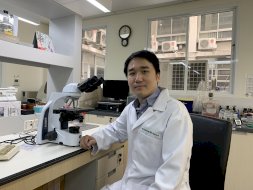
by Federica Montagnese
Publication:
JAMA Neurol 2021 May 28
doi: 10.1001/jamaneurol.2021.1509
Clinicopathologic Features of Oculopharyngodistal Myopathy With LRP12 CGG Repeat Expansions Compared With Other Oculopharyngodistal Myopathy Subtypes
Theerawat Kumutpongpanich and Masashi Ogasawara et al.
https://pubmed.ncbi.nlm.nih.gov/34047774/
The oculopharyngodistal myopathy (OPDM) is a rare muscle disease first described in Japan and later on in other ethnicities. The genetic cause of OPDM was long unrecognized until 2019 CGG repeat expansions in LRP12, GIPC1 and NOTCH2NLC have been reported as the cause of OPDM in the majority of clinically diagnosed patients. In this manuscript the authors provide a detailed clinical and pathological description of 65 patients with OPDM due to LRP12 mutation. The inheritance pattern seems autosomal dominant, possibly with incomplete penetrance and anticipation in some families. The mean age at onset was 41 years (range 17-62y) and the most common initial symptoms were ptosis and distal limb weakness. During the course of the disease ptosis, bulbar weakness and limb muscle weakness were present in more than 97% of patients. Ophthalmoplegia was observed in 83% of patients. The CK was mildly elevated 470 IU/L (range: 30-1674 IU/L). Loss of ambulation and respiratory insufficiency may occur during the course of the disease. Some patients showed cardiac involvement (2 with cardiomyopathy, 5 with atrial fibrillation). Compared to previously reported NOTCH2NLC cases, no relevant CNS involvement has been observed in the patients included in this study, neither clinically or on cMRI. The most striking finding on muscle biopsies, performed in 42 pts, was the presence of rimmed vacuoles and small angular fibres (100%). The authors could also review muscle imaging data at lower limbs and found that the soleus and the medial head of the gastrocnemius were the most affected distally, the biceps femoris, adductor magnus and semimembranosus proximally.
In summary, this study highlights the distinctive features of LRP12-OPDM in comparison to other forms associated with GIPC1 and NOTCH2NLC or OPDM cases not yet genetically defined. It also highlights the clinical overlap with oculopharyngeal muscular dystrophy (OPMD) and the importance of the genetic characterization of patients.

I obtained my medical degree and diploma in neurology from Siriraj hospital, Mahidol university in Thailand. After training, I had an opportunity to do the research and study muscle pathology with Professor Nishino for 2 years at National center of neurology and psychiatry in Japan. My work focuses primarily on exploring clinical and pathological features in genetic and acquired muscle diseases and also their novel therapeutic options. I am now an attending physician in neurology department, Siriraj hospital.

I graduated in medicine from Shinshu university and then I had been working as a pediatrician for 6 years in Hokkaido. Then, I came to Tokyo to learn pediatric neurology and worked with professor Nishino as a researcher at National Center of Neurology and Psychiatry, Kodaira, Tokyo, Japan. My work focuses mainly on researching clinical, genetical, and pathological findings on oculopharyngodistal myopathy (OPDM) and oculopharyngeal muscular dystrophy (OPMD). Now, I am working at department of Pediatrics, Showa General Hospital in Tokyo, Japan.

Federica Montagnese's research focus is on the clinical and myopathological aspects of metabolic myopathies, myotonic syndromes and muscular dystrophies. She is responsible for the maintenance of the National Registries for myotonic dystrophies and FSHD. She is member of the EAN Subspecialty Panels of “Neurogenetics” and “Muscle disorders”.
This article is presented by the
Publication Highlights Committee.
Published on 1 July 2021.